+ Open data
Open data
- Basic information
Basic information
| Entry |  | |||||||||
|---|---|---|---|---|---|---|---|---|---|---|
| Title | Cyanophage Pam3 baseplate proteins | |||||||||
 Map data Map data | ||||||||||
 Sample Sample |
| |||||||||
| Biological species |  uncultured cyanophage (environmental samples) uncultured cyanophage (environmental samples) | |||||||||
| Method | single particle reconstruction / cryo EM / Resolution: 3.19 Å | |||||||||
 Authors Authors | Yang F / Jiang YL / Zhou CZ | |||||||||
| Funding support |  China, 1 items China, 1 items
| |||||||||
 Citation Citation |  Journal: Proc Natl Acad Sci U S A / Year: 2023 Journal: Proc Natl Acad Sci U S A / Year: 2023Title: Fine structure and assembly pattern of a minimal myophage Pam3. Authors: Feng Yang / Yong-Liang Jiang / Jun-Tao Zhang / Jie Zhu / Kang Du / Rong-Cheng Yu / Zi-Lu Wei / Wen-Wen Kong / Ning Cui / Wei-Fang Li / Yuxing Chen / Qiong Li / Cong-Zhao Zhou /  Abstract: The myophage possesses a contractile tail that penetrates its host cell envelope. Except for investigations on the bacteriophage T4 with a rather complicated structure, the assembly pattern and tail ...The myophage possesses a contractile tail that penetrates its host cell envelope. Except for investigations on the bacteriophage T4 with a rather complicated structure, the assembly pattern and tail contraction mechanism of myophage remain largely unknown. Here, we present the fine structure of a freshwater cyanophage Pam3, which has an icosahedral capsid of ~680 Å in diameter, connected via a three-section neck to an 840-Å-long contractile tail, ending with a three-module baseplate composed of only six protein components. This simplified baseplate consists of a central hub-spike surrounded by six wedge heterotriplexes, to which twelve tail fibers are covalently attached via disulfide bonds in alternating upward and downward configurations. In vitro reduction assays revealed a putative redox-dependent mechanism of baseplate assembly and tail sheath contraction. These findings establish a minimal myophage that might become a user-friendly chassis phage in synthetic biology. | |||||||||
| History |
|
- Structure visualization
Structure visualization
| Supplemental images |
|---|
- Downloads & links
Downloads & links
-EMDB archive
| Map data |  emd_33802.map.gz emd_33802.map.gz | 393.7 MB |  EMDB map data format EMDB map data format | |
|---|---|---|---|---|
| Header (meta data) |  emd-33802-v30.xml emd-33802-v30.xml emd-33802.xml emd-33802.xml | 19.6 KB 19.6 KB | Display Display |  EMDB header EMDB header |
| Images |  emd_33802.png emd_33802.png | 184.3 KB | ||
| Others |  emd_33802_half_map_1.map.gz emd_33802_half_map_1.map.gz emd_33802_half_map_2.map.gz emd_33802_half_map_2.map.gz | 337.9 MB 337.8 MB | ||
| Archive directory |  http://ftp.pdbj.org/pub/emdb/structures/EMD-33802 http://ftp.pdbj.org/pub/emdb/structures/EMD-33802 ftp://ftp.pdbj.org/pub/emdb/structures/EMD-33802 ftp://ftp.pdbj.org/pub/emdb/structures/EMD-33802 | HTTPS FTP |
-Validation report
| Summary document |  emd_33802_validation.pdf.gz emd_33802_validation.pdf.gz | 929 KB | Display |  EMDB validaton report EMDB validaton report |
|---|---|---|---|---|
| Full document |  emd_33802_full_validation.pdf.gz emd_33802_full_validation.pdf.gz | 928.5 KB | Display | |
| Data in XML |  emd_33802_validation.xml.gz emd_33802_validation.xml.gz | 17.9 KB | Display | |
| Data in CIF |  emd_33802_validation.cif.gz emd_33802_validation.cif.gz | 21.3 KB | Display | |
| Arichive directory |  https://ftp.pdbj.org/pub/emdb/validation_reports/EMD-33802 https://ftp.pdbj.org/pub/emdb/validation_reports/EMD-33802 ftp://ftp.pdbj.org/pub/emdb/validation_reports/EMD-33802 ftp://ftp.pdbj.org/pub/emdb/validation_reports/EMD-33802 | HTTPS FTP |
-Related structure data
| Related structure data | 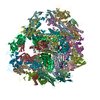 7yfzMC 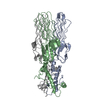 7yfwC 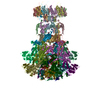 8hdrC 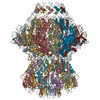 8hdsC 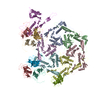 8hdtC 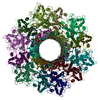 8hdwC M: atomic model generated by this map C: citing same article ( |
|---|
- Links
Links
| EMDB pages |  EMDB (EBI/PDBe) / EMDB (EBI/PDBe) /  EMDataResource EMDataResource |
|---|
- Map
Map
| File |  Download / File: emd_33802.map.gz / Format: CCP4 / Size: 421.9 MB / Type: IMAGE STORED AS FLOATING POINT NUMBER (4 BYTES) Download / File: emd_33802.map.gz / Format: CCP4 / Size: 421.9 MB / Type: IMAGE STORED AS FLOATING POINT NUMBER (4 BYTES) | ||||||||||||||||||||
|---|---|---|---|---|---|---|---|---|---|---|---|---|---|---|---|---|---|---|---|---|---|
| Voxel size | X=Y=Z: 1.07 Å | ||||||||||||||||||||
| Density |
| ||||||||||||||||||||
| Symmetry | Space group: 1 | ||||||||||||||||||||
| Details | EMDB XML:
|
-Supplemental data
-Half map: #2
| File | emd_33802_half_map_1.map | ||||||||||||
|---|---|---|---|---|---|---|---|---|---|---|---|---|---|
| Projections & Slices |
| ||||||||||||
| Density Histograms |
-Half map: #1
| File | emd_33802_half_map_2.map | ||||||||||||
|---|---|---|---|---|---|---|---|---|---|---|---|---|---|
| Projections & Slices |
| ||||||||||||
| Density Histograms |
- Sample components
Sample components
-Entire : uncultured cyanophage
| Entire | Name:  uncultured cyanophage (environmental samples) uncultured cyanophage (environmental samples) |
|---|---|
| Components |
|
-Supramolecule #1: uncultured cyanophage
| Supramolecule | Name: uncultured cyanophage / type: virus / ID: 1 / Parent: 0 / Macromolecule list: all / NCBI-ID: 215796 / Sci species name: uncultured cyanophage / Virus type: VIRION / Virus isolate: OTHER / Virus enveloped: No / Virus empty: No |
|---|---|
| Host (natural) | Organism:  Pseudanabaena mucicola (bacteria) Pseudanabaena mucicola (bacteria) |
-Macromolecule #1: Pam3 baseplate wedge gp22
| Macromolecule | Name: Pam3 baseplate wedge gp22 / type: protein_or_peptide / ID: 1 / Number of copies: 12 / Enantiomer: LEVO |
|---|---|
| Source (natural) | Organism:  uncultured cyanophage (environmental samples) uncultured cyanophage (environmental samples) |
| Molecular weight | Theoretical: 32.686787 KDa |
| Sequence | String: MTYGVQPTGY VKKPLAVHLA EIEASMVDLF GPGVIQTEQS PLGQLNGLYA DLSYDLDERG EDLYQSFDPE QAEGSRLDIL ARYRLLSRR AGESDESFRR AITNVDRARI DLSDLSTALS AINGVSWSRV YVNEDATTDA DGIPPNTVSV AVIGGDDDEV A QLVRRYVV ...String: MTYGVQPTGY VKKPLAVHLA EIEASMVDLF GPGVIQTEQS PLGQLNGLYA DLSYDLDERG EDLYQSFDPE QAEGSRLDIL ARYRLLSRR AGESDESFRR AITNVDRARI DLSDLSTALS AINGVSWSRV YVNEDATTDA DGIPPNTVSV AVIGGDDDEV A QLVRRYVV PGVGMYGNTT IETTIGGFCR RIRVIRPVLI PTSVEIDVQS RPLKNGCPPP SVNAMAAGLY TELTGPDRPG NG EDGTVYL FRKIMERLYP NVEVVDVRLS QAPAAPTTPP LVMSFFQMMS FNADDILVEI VP |
-Macromolecule #2: Pam3 baseplate wedge gp23
| Macromolecule | Name: Pam3 baseplate wedge gp23 / type: protein_or_peptide / ID: 2 / Number of copies: 6 / Enantiomer: LEVO |
|---|---|
| Source (natural) | Organism:  uncultured cyanophage (environmental samples) uncultured cyanophage (environmental samples) |
| Molecular weight | Theoretical: 26.194811 KDa |
| Sequence | String: MSNLCADPEA LVEARIDEVL TQYRESPYLL NLIRAYLSKL AETSMSYCDM VEKFDLDTAV GDQLTIIGRI LGFPRCHCVC DTIPVVGYD CGGSYAGSYQ LAGYCEPGSS WIHCSPYGNS ELCVDEDEIY RSLLKARRYQ MLGLYDIESL HEALQIVWGE D AMVAETKV ...String: MSNLCADPEA LVEARIDEVL TQYRESPYLL NLIRAYLSKL AETSMSYCDM VEKFDLDTAV GDQLTIIGRI LGFPRCHCVC DTIPVVGYD CGGSYAGSYQ LAGYCEPGSS WIHCSPYGNS ELCVDEDEIY RSLLKARRYQ MLGLYDIESL HEALQIVWGE D AMVAETKV GQVVVTPGRS LTATETRYLP IVFRALPIAP GIKGMIHIDQ GPIAGYGDGW AGYCGGDWLC PVDPHAYTCS |
-Macromolecule #3: Pam3 sheath initiator gp21
| Macromolecule | Name: Pam3 sheath initiator gp21 / type: protein_or_peptide / ID: 3 / Number of copies: 6 / Enantiomer: LEVO |
|---|---|
| Source (natural) | Organism:  uncultured cyanophage (environmental samples) uncultured cyanophage (environmental samples) |
| Molecular weight | Theoretical: 13.889669 KDa |
| Sequence | String: MAAPSRIGLA LKKNEQGIAD IYLDASGNLS MVQNTEAVGQ HARQRLMTYL GEWFLNKNVG VPWLRDLLGK GYDPVLAEAV IKAEILSTD GVTEITSFSI RFDQGRRALE AFDIEVTTEY DEETVL |
-Macromolecule #4: Pam3 tube initiator gp17
| Macromolecule | Name: Pam3 tube initiator gp17 / type: protein_or_peptide / ID: 4 / Number of copies: 6 / Enantiomer: LEVO |
|---|---|
| Source (natural) | Organism:  uncultured cyanophage (environmental samples) uncultured cyanophage (environmental samples) |
| Molecular weight | Theoretical: 19.854342 KDa |
| Sequence | String: MIIAFSSAIG PVPLTVVISE KHTSKVELTT NPIESGADVT DHAYVKGKEI ELEVADRNAA ATWAALVAFQ ESRVPFVLMT GLSMYRNMI ITEIDATRNA QHSKILKGTV RLREVKIVET GTAEDSSGKD GTDKNKSSNP SKDKAADAKT ADKANSGVNA G DKGGTTVA APRAQSLLKG VFGGSSASGG AAP |
-Macromolecule #5: Pam3 plug gp18
| Macromolecule | Name: Pam3 plug gp18 / type: protein_or_peptide / ID: 5 / Number of copies: 6 / Enantiomer: LEVO |
|---|---|
| Source (natural) | Organism:  uncultured cyanophage (environmental samples) uncultured cyanophage (environmental samples) |
| Molecular weight | Theoretical: 11.724286 KDa |
| Sequence | String: MIELEVLDES KQKFSVILND RRVTIELWYN TTNDRWSFSL ALDGDNVVTG RRLVTGVDLL APFGLGIGAL FLLSENGEPP TRANLPLGL VKLYHATQEE IDAAISA |
-Macromolecule #6: Pam3 hub gp19
| Macromolecule | Name: Pam3 hub gp19 / type: protein_or_peptide / ID: 6 / Number of copies: 3 / Enantiomer: LEVO |
|---|---|
| Source (natural) | Organism:  uncultured cyanophage (environmental samples) uncultured cyanophage (environmental samples) |
| Molecular weight | Theoretical: 25.201736 KDa |
| Sequence | String: MLEVGYTPPG GGNNIGIIAK GKIRDYQHDR EGGDIISTVS CGDGDKAYRR ATISKTIPKG TPLTEVVDEI HKEMKKEGIA KGEWSFPDK VKNTQLKRPY SMCGSCTREL DTLGRSHGFY WNIQNETMEI IPGNGHLPGS LLITPDTGLI GTPTITDNGI K VKALINPE ...String: MLEVGYTPPG GGNNIGIIAK GKIRDYQHDR EGGDIISTVS CGDGDKAYRR ATISKTIPKG TPLTEVVDEI HKEMKKEGIA KGEWSFPDK VKNTQLKRPY SMCGSCTREL DTLGRSHGFY WNIQNETMEI IPGNGHLPGS LLITPDTGLI GTPTITDNGI K VKALINPE ARPNRMMKVK SQVLKMNRKG EDYRISEVSF NGDNQEGDWI MTLTGEAIGG DKKVDEGKKA K |
-Macromolecule #7: Pam3 spike gp20
| Macromolecule | Name: Pam3 spike gp20 / type: protein_or_peptide / ID: 7 / Number of copies: 3 / Enantiomer: LEVO |
|---|---|
| Source (natural) | Organism:  uncultured cyanophage (environmental samples) uncultured cyanophage (environmental samples) |
| Molecular weight | Theoretical: 23.537537 KDa |
| Sequence | String: MTGYLGKTTN QDRDVVSAVA QSERESVWGE MPGRVVSVSA DGRTVTVQPL YKPKFNGVPT DMPVLQEVPL RQALMGGVGV TVPVKPGQN VTLRPQMRSM DNYHVEGDGS ASDSRSFSLS DMEAHIAGGE SLKDVIPNLD SENVHVRANA DGSKGMKLSP E GKVEFQGP ...String: MTGYLGKTTN QDRDVVSAVA QSERESVWGE MPGRVVSVSA DGRTVTVQPL YKPKFNGVPT DMPVLQEVPL RQALMGGVGV TVPVKPGQN VTLRPQMRSM DNYHVEGDGS ASDSRSFSLS DMEAHIAGGE SLKDVIPNLD SENVHVRANA DGSKGMKLSP E GKVEFQGP EGNLLDLIAD FMELVANDKL QINYGSSAGT NHAMANKAAM LALAAKVRTT GTI |
-Experimental details
-Structure determination
| Method | cryo EM |
|---|---|
 Processing Processing | single particle reconstruction |
| Aggregation state | particle |
- Sample preparation
Sample preparation
| Buffer | pH: 7.5 |
|---|---|
| Vitrification | Cryogen name: ETHANE / Chamber humidity: 100 % / Chamber temperature: 300 K |
- Electron microscopy
Electron microscopy
| Microscope | FEI TITAN KRIOS |
|---|---|
| Image recording | Film or detector model: GATAN K2 SUMMIT (4k x 4k) / Average electron dose: 50.0 e/Å2 |
| Electron beam | Acceleration voltage: 300 kV / Electron source:  FIELD EMISSION GUN FIELD EMISSION GUN |
| Electron optics | Illumination mode: SPOT SCAN / Imaging mode: BRIGHT FIELD / Nominal defocus max: 2.0 µm / Nominal defocus min: 1.0 µm |
| Experimental equipment |  Model: Titan Krios / Image courtesy: FEI Company |
- Image processing
Image processing
| Final reconstruction | Resolution.type: BY AUTHOR / Resolution: 3.19 Å / Resolution method: FSC 0.143 CUT-OFF / Software - Name: RELION (ver. 3.1) / Number images used: 45155 |
|---|---|
| Initial angle assignment | Type: RANDOM ASSIGNMENT |
| Final angle assignment | Type: RANDOM ASSIGNMENT |
 Movie
Movie Controller
Controller









 Z
Z Y
Y X
X

















